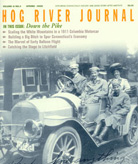(c) Connecticut Explored Inc. Spring 2008
Subscribe/Buy the Issue!
Do you remember going for a Sunday drive? “Back in the day,” my family would pile into the car after
church and go for a spin—just for the enjoyment of the scenery. My brother and sister and I thought the windy, bumpy roads were the best—to “lose your stomach,” but hopefully not “your lunch.” That sensation after going over a bump is one that, due to better shocks and improved roads, I haven’t experienced in year. And, with gas presently costing more than $3 a gallon and many miles logged getting to the myriad places I need to be each week, the idea of a Sunday drive now seems quaint, even frivolous.
I was surprised to learn, then, that automotive history has its roots in the pleasure drive and sport racing, well before cars were considered indispensable for getting from point A to point B. A century ago, the average person would have taken the train or the trolley to get to a destination beyond walking distance. The advent of the bicycle introduced the idea that the average person should be able to get to a destination on his or her own schedule and not the railroad’s. From there a mass market evolved for a personal vehicle with a motor, a.k.a. the automobile. (Hartford’s PopeManufacturing Company, maker first of bicycles and then automobiles in the 1870s to 1910s, is the star of that story. See “The Horseless Era Arrives,” Spring 2005, and “Columbia Bicycles: The Vehicle of Healthful Happiness,” Spring 2003.)
Early on, though, Sunday drives or auto touring on any day of the week were not for the faint of heart, as our photo essay (page 18) reveals. Stephen Goddard notes in Getting There (Basic Books,
1994) that in 1917, 90 percent of America’s roads were still “muddy, rutted, dirt paths, threatening
to mire motor vehicles up to their hubs.” And since as soon as the car was developed there came the urge to race it, we feature a whirlwind history tour of Connecticut racetracks in this issue’s Destination (page 52).
The problem of bad roads initially held the U.S. auto industry back. But roads have been both a problem and a solution for more than 200 years. Two stories in this issue, one about Litchfield in the heyday of the stagecoach and the other about the capital region’s 1960s highway to nowhere, explore aspects of the impact of road placement on our cities and towns. This issue’s Soapbox makes the case for resisting the impulse to widen and increase traffic capacity on one of Connecticut’s historic roadways in favor of preserving it as the pleasure drive it was originally designed to be. In other stories, we go beyond “wheeled travel” to cover our drive to use water and air to transport goods and people, including the doomed- from-the-start effort to build a canal from New Haven to Northampton, Massachusetts; the misadventures of early balloonist Silas Brooks; and the famous-for-aeronautical innovation Vought-Sikorsky Aircraft Plant in Stratford.
Connecticut has always been a state on the move. Building on and recovering from our mixed transportation legacy is a key issue before us. Will mass transit and the electric car rise again? Like our story on Connecticut’s historic roller coasters, sometimes, what goes around, comes around.
Explore!
Read all of the stories in the Spring 2008 issue
Read all of our stories about Travel and Transportation on our TOPICS page

